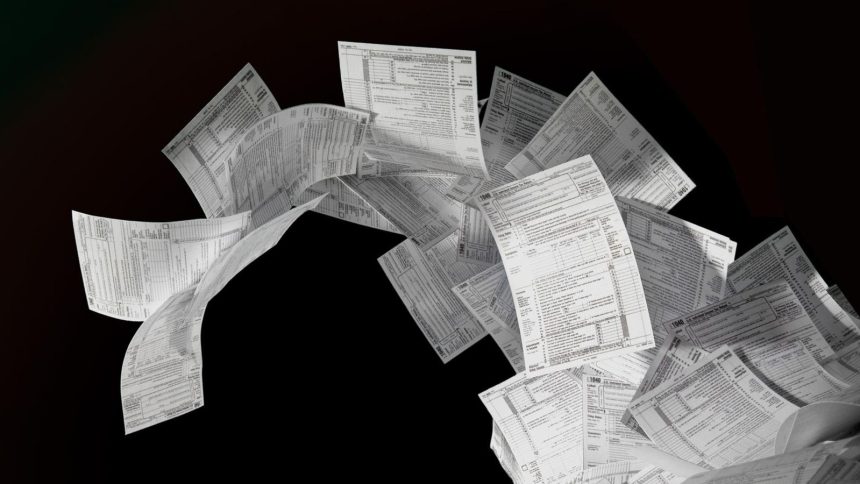Some mutual funds inflict great damage on your 1040. Defend yourself.
By William Baldwin, Senior Contributor
Winter: the season in which fund owners incur self-inflicted wounds.
Investors who make the mistake of holding stock mutual funds in taxable accounts are at risk of having unwanted distributions dumped in their laps. This often occurs in December. They pay the price the following April.
Case in point: the JP Morgan Tax Aware Equity Fund. The name says that it’s going to be kind to taxpayers. The reality is something else. The fund has confessed that a fat, taxable distribution of capital gains will arrive before the year is out.
If you hold this fund anywhere but in a tax-sheltered account, you will be sharing some of your investment with the tax collector. The payout will come to 21.4% of your account, and you will owe federal tax on the distribution, at a rate up to 23.8%. State income taxes are on top.
Fund vendors often telegraph their punches. This table displays other funds that have warned shareholders of impending damage.
BRACE YOURSELF
Holders of any of these investment companies will get a capital gain distribution for 2023, whether they want it or not.
Sometimes there’s nothing you can do about it. If you have owned one of these funds for a long while, resistance is futile.
Let’s suppose you got into a fund years ago at $20, saw its portfolio appreciate to $25 per fund share, and note that a $5 distribution of capital gains is now en route. If you stand pat you’ll have a $5 capital gain distribution to report. If you flee before the payout, you’ll have the same $5 long-term gain to report.
How do funds wind up in this situation? By selling portfolio positions at a profit. There are two ways that can happen.
One is if a trigger-happy portfolio manager sells winners in order to reinvest in something more attractive. Presumably a “tax aware” fund will avoid such behavior. But most funds are rather nonchalant about taxes.
The other cause of unwanted payouts is redemptions. When customers decamp, the manager is forced to liquidate holdings in order to cash them out. If he has run out of losers he sells appreciated stocks. Once the fund has exhausted any loss carryforward, it is compelled to distribute gains on those stocks to the dwindling band of surviving shareholders. Victims include latecomers who are underwater on their fund shares.
There are preventives and there are antidotes. Consider these six strategies.
1. Locate investments wisely.
An actively managed stock fund should go in your tax-sheltered account. If there’s no room for it there, don’t buy it.
2. Exit weak funds.
Suppose, in our example, you got into the fund at $24 and then it declares a $5 dividend. You could sell before the payout and report a $1 gain. Or you could sell after, getting a $5 dividend offset by a $4 loss on the fund share, for the same net $1 long gain on which to pay tax. It doesn’t matter whether you get out before or after the dividend. The key here: the ex-dividend price of the fund, $20, is less than your purchase price, $24.
3. Look before investing.
Morningstar reports a “tax cost ratio” for funds that have been around for a while. It’s based on past distributions, but it’s a pretty good indication of how much trouble a fund will cause you in the future.
Among funds that hold either only U.S. stocks or a blend of stocks and bonds, here are the worst offenders:
FUND TAX BURDENS: THE WORST
These funds create enormous tax damage with their distributions. Their expense ratios are no bargain, either.
The tax cost ratio is defined as the average annual percentage loss to federal income taxes for holders in top brackets. Thus, if in one year a fund would have turned your $100 into $130 inside a tax-free account but only $117 in a taxable account, it would show a cost ratio of 10%.
Access the ratio by selecting Morningstar’s “performance” tab and then clicking on “month-end.”
Morningstar’s calculation does not reflect the capital gain (or loss) that would occur on a sale of fund shares. It does not include either state income tax or the many ways that a distribution can boomerang on your return by boosting your adjusted gross income. For many investors, even the ones not in top brackets, it understates the erosion of income taxes.
The sinners table is limited to domestic stock funds that have been around for a decade, haven’t kept up with the overall stock market before tax, and have run up a tax cost of at least 5% a year. Really bad apples.
But take note that there are many slightly rotten apples that didn’t qualify for display. A reasonable expectation for the real return on stocks—return above inflation—is 4% a year. A misbegotten fund wipes out this return.
4. Consider getting a “tax aware” fund.
But only if it’s cheap.
Here’s a catalog of stock and balanced funds sporting “tax” in the name. The ones from Vanguard are good buys. Most of the rest should be avoided.
TAX-MANAGED FUNDS
These equity and balanced mutual funds aim to keep your taxes low—and sometimes accomplish that only by running up stiff expenses. For comparison: one iShares exchange-traded fund, which advertises no special effort to minimize taxes but nonetheless does that merely by dint of being an ETF.
Turns out that one way to achieve a low tax cost ratio is by gouging shareholders. Expenses get taken off the top, reducing the taxable income that must be distributed. Pay attention to the combined cost of ownership: taxes plus expenses.
5. Harvest losses.
Whether or not you are afflicted by capital gain distributions, loss harvesting is good financial hygiene. Capital losses and loss carryforwards can offset lots of things, such as gain from a house sale.
The idea is to sell a losing position, stay out for 31 days, then buy it back. While you’re on the sidelines, protect against a rebound by temporarily holding a replacement.
If you lost money on Exxon Mobil you’d sell and immediately buy Chevron, then a month later reverse the trades, assuming Exxon is the stock you’d rather own. If you hold both and have lost money on both you’d sell Exxon, double up the Chevron, and after a month sell the higher-cost Chevron shares and reestablish the Exxon position. Or, hold your place in the oil sector with a temporary stake in Fidelity MSCI Energy Exchange-Traded Fund.
6. Prefer ETFs.
There are two reasons why an exchange-traded one is the only kind of stock fund to hold in a taxable account. One is that most ETFs track indexes, so there’s no reason for them to shuffle their portfolios. The other is that they can use a peculiar loophole, involving swaps of securities with ETF market makers, that makes capital gains vanish. Mutual funds can’t easily use the loophole. There are cases where equity ETFs are forced to disgorge gains—the iShares Taiwan fund in the first table above being one such—but they are quite rare.
Bottom line: Given all the ways to avoid it, you have only yourself to blame for discomfort caused by cap gain dividends.
MORE FROM FORBES
Read the full article here









